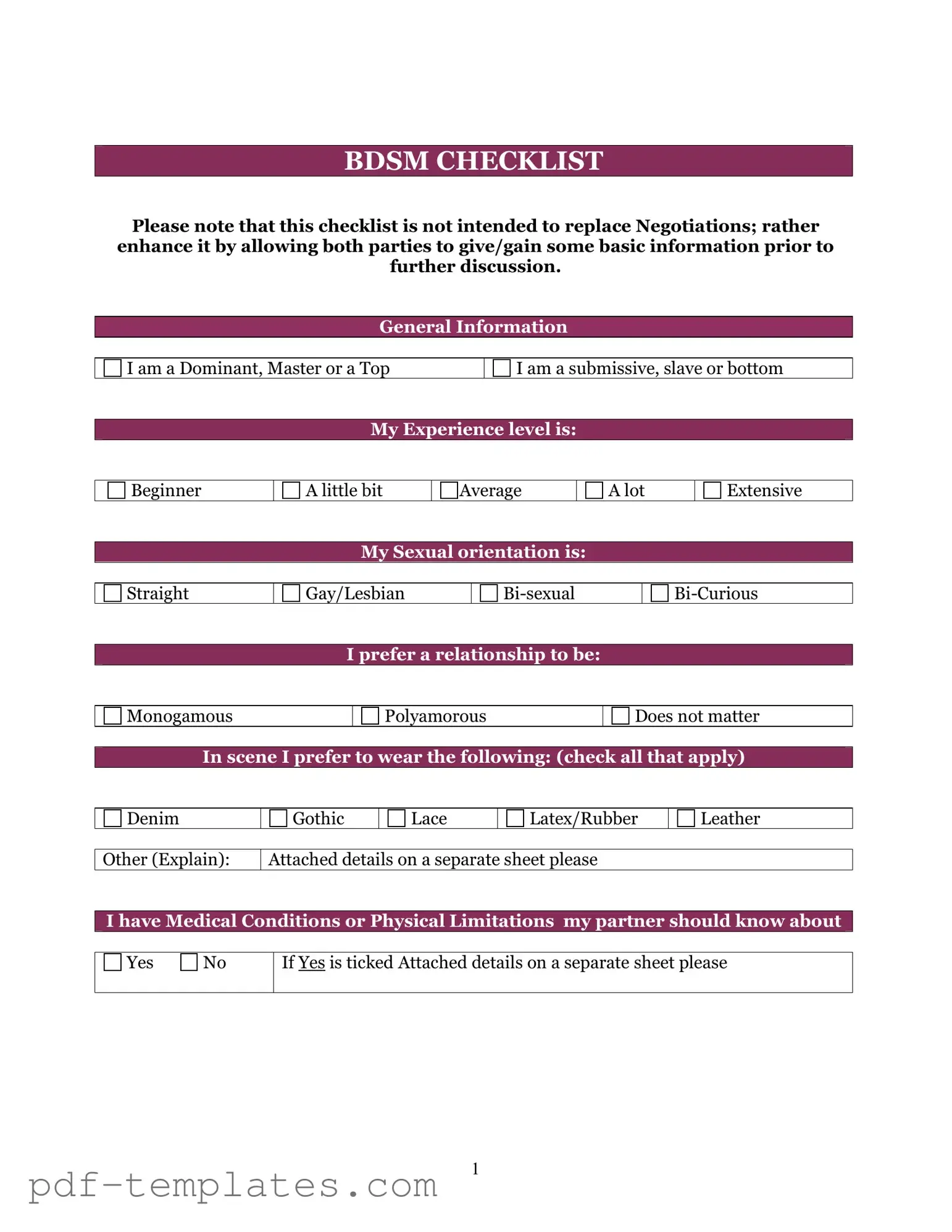The BDSM Checklist form is akin to a consent form used in various therapeutic settings. Both documents aim to clarify boundaries and preferences, ensuring that all parties involved understand what is acceptable and what is not. Just as a therapist may ask clients to outline their comfort levels regarding sensitive topics, the BDSM Checklist encourages individuals to express their desires and limits within a BDSM context. This fosters open communication and trust, which are crucial for safe and consensual experiences.
Another similar document is a medical history form. This form collects vital information about a person's health and past medical conditions. In the same way, the BDSM Checklist gathers information about a participant's experiences and preferences. Both forms serve as tools for understanding the individual's background and ensuring that any activities undertaken are safe and appropriate for their specific circumstances.
The informed consent document used in research studies shares similarities with the BDSM Checklist. Informed consent requires participants to understand the nature of the study, any risks involved, and their right to withdraw at any time. Similarly, the BDSM Checklist ensures that all parties are fully aware of the activities they are engaging in and have the right to set boundaries or withdraw consent at any moment. Both documents prioritize the autonomy and safety of the participants.
Safety contracts used in various alternative lifestyles also resemble the BDSM Checklist. These contracts outline specific agreements between partners regarding safety protocols, limits, and aftercare. Just like the BDSM Checklist, safety contracts emphasize the importance of clear communication and mutual understanding to create a secure environment for all involved.
Another comparable document is the personal safety plan often used in domestic violence prevention programs. A personal safety plan helps individuals identify safe spaces, trusted contacts, and strategies for avoiding dangerous situations. Similarly, the BDSM Checklist allows individuals to articulate their safe words and limits, ensuring that everyone knows how to navigate potential risks within BDSM practices.
Relationship agreements, often found in polyamorous or open relationships, also share characteristics with the BDSM Checklist. These agreements outline the expectations and boundaries within a relationship. Like the BDSM Checklist, they promote transparency and understanding among partners, helping to prevent misunderstandings and fostering a healthier dynamic.
For families looking to start their homeschooling journey, utilizing the Texas Homeschool Letter of Intent form is crucial. This form acts as the official notification to the state, ensuring compliance with homeschooling regulations and guidelines. To learn more, check out this resource: essential Texas Homeschool Letter of Intent information.
Event waivers, commonly used in activities like skydiving or extreme sports, are similar to the BDSM Checklist in that they require participants to acknowledge risks and agree to terms before engaging in an activity. Both documents aim to protect the organizers and participants by ensuring that everyone is aware of potential dangers and consents to proceed under those conditions.
The negotiation form used in kink communities is another document that aligns closely with the BDSM Checklist. Negotiation forms serve as a preliminary discussion tool for partners to express their desires and limits before engaging in BDSM activities. This process mirrors the checklist's purpose of ensuring that all parties are on the same page regarding their interests and boundaries.
Finally, a personal values assessment form can be compared to the BDSM Checklist. Personal values assessments help individuals clarify their beliefs and priorities in various areas of life. Similarly, the BDSM Checklist allows individuals to reflect on their preferences and limits within the context of BDSM, enabling them to make informed decisions about their experiences.
